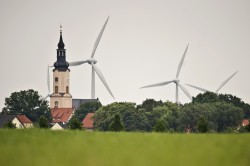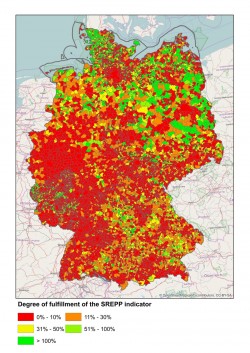press release, 04. October 2016
Strong at the coast, weak in the cities the German energy-transition patchwork
UFZ researchers create a detailed energy-transition map
The energy transition in German is making progress. In 2015, hydropower, wind, sun and biomass provided about 35% of electricity. The ambitious transition to climate-friendly energy provision is moving ahead in all federal states. But from region to region there are huge differences. These have now been identified by scientists at the Helmholtz Centre for Environmental Research (UFZ). Their detailed study on the spatial distribution of the German electricity supply has resulted in a detailed energy-transition map. It clearly shows pioneers and stragglers among all 12,066 German municipalities, and shows how Germany can stay true to its role as a global example into the future.

Photo: UFZ / André Künzelmann

Photo: Applied Energy/Elsevier
"The decentralised energy transition is a reality, and is taking place over the entire country," said Prof. Dr.-Ing. Daniela Thrän, who leads the Bioenergy Department at the UFZ and researches at the German Biomass Research Center (DBFZ). Way ahead are municipalities on the west coast of the state of Schleswig-Holstein, with numerous wind parks and biogas plants. Broad areas in Brandenburg and Saxony-Anhalt are also strong in the generation of renewable energy from wind, sun and biomass. Cities such as Berlin or industrial conurbations in Hessen and Baden-Württemberg, however, need to catch up.
Daniela Thrän’s team investigated how far the transition to CO2-neutral electricity generation has already progressed in all 12,066 of Germany’s municipalities, publishing the results in the scientific journal Applied Energy. To do this, the researchers analysed all available data up to the middle of 2015 regarding electricity production and consumption. The result is a map of the German energy transition, on which every citizen can see the progress made in their home municipality. "There is a clear spatial dissonance between consumption and production", says Daniela Thrän. For rural areas with lots of space for wind and solar farms but a low population density, it is easier to score well. But densely populated areas with a high level of industry have more work to do, adds Sebastian Rauner, main author of the study.
In Germany, overall electricity generation by the 770 conventional coal, gas and nuclear power stations is up against the respectively lower amounts of electricity generated by the more than 1.5 million solar, biogas and wind plants spread over the whole country. The researchers considered these figures in relation to regional electricity consumption. On average, this was 1.32 kilowatt hours per square metre each year. Densely populated towns and industrial regions therefore inevitably had higher values than less densely populated rural municipalities. "But that doesn’t mean that someone living in a rural area is automatically better at climate protection than a city-dweller," stresses Daniela Thrän.
When evaluating the individual municipalities, the interplay between renewable electricity producers was particularly important to the UFZ researchers. Ideally, wind and solar farms with weather-dependent electricity production should be combined with flexible power stations using biomass or hydropower, for example. Because it is only by working together that a high level of supply reliability can be assured, around the clock and throughout the year. Based on these relevant factors, the researchers developed an energy-transition indicator (Smart Renewable Power Provision indicator, SREPP), which takes into account not only the pure amount of electricity, but also the flexibility of a decentralised group of power stations.
"From Flensburg to Konstanz, from Aachen to Görlitz, the German energy transition is doing well so far," says Daniela Thrän. But in the phase now beginning, the spatial differences must be reduced. "I consider incentives for areas with less development up to now to be an important factor bearing in mind the upcoming reforms of the Renewable Energy Act (Erneuerbare Energien Gesetz - EEG)," says the environmental engineer. With stronger spatial planning, even Germany’s ambitious climate goals, combined with effective protection against blackouts and limited expansion of the power grids, remain reachable.
In the future, too, Daniela Thrän and her colleagues will keep an eye on the fundamental transition of Germany’s electricity supply. They are planning the next energy-transition map for 2017. Then data on electricity consumption and electricity generation beyond 2014 will also be taken into account - for example the yield from the first offshore wind power stations in the North and Baltic Seas. In addition, they want to look more closely at public acceptance - also an important aspect of the energy transition, but one that is difficult to measure.
Publication:
Sebastian Rauner, Marcus Eichhorn, Daniela Thrän: The spatial dimension of the power system: Investigating hot spots of Smart Renewable Power Provision, Applied Energy, DOI: 10.1016/j.apenergy.2016.07.031
http://dx.doi.org/10.1016/j.apenergy.2016.07.031
Further information
Prof. Dr. Daniela Thrän
Head of Department of Bioenergy
daniela.thraen@ufz.de
UFZ press office
Susanne Hufe
Phone: +49 341 235-1630
presse@ufz.de
In the Helmholtz Centre for Environmental Research (UFZ), scientists conduct research into the causes and consequences of far-reaching environmental changes. Their areas of study cover water resources, ecosystems of the future, environmental technologies and biotechnologies, the effects of chemicals in the environment, modelling and social-scientific issues. The UFZ employs more than 1,100 staff at its sites in Leipzig, Halle and Magdeburg. It is funded by the Federal Government, Saxony and Saxony-Anhalt.
www.ufz.deThe Helmholtz Association contributes to solving major challenges facing society, science and the economy with top scientific achievements in six research fields: Energy; Earth and Environment; Health; Key Technologies; Matter; and Aeronautics, Space and Transport. With some 39,000 employees in 19 research centres, the Helmholtz Association is Germany’s largest scientific organisation.
www.helmholtz.de